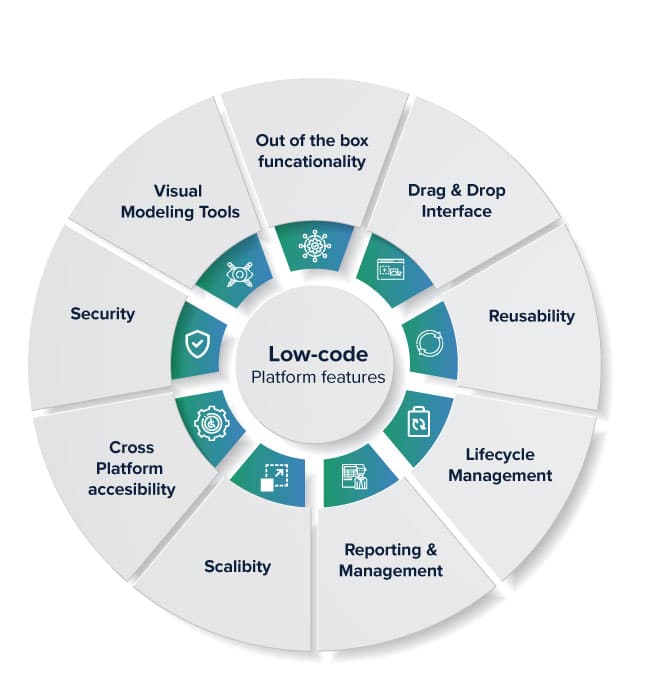Handy News For Choosing Low-Code Platform Sites
Handy News For Choosing Low-Code Platform Sites
Blog Article
Benefits Of Low-Code Application Development In Terms Of Accessibility For Non-Developers
Due to a number of factors the development of low-code applications is easier to non-developers. These are often called "citizens developers."
Drag-and -Drop Builders. Low-code platforms include drag-and -drop interfaces. This provides non-programmers with the possibility of building applications visually, without writing code. This makes the process of development easier for those who have little or no technical expertise.
WYSIWYG editor: The "What you see is what you will get" editors let users design interfaces, workflows, and other functions in a manner which closely resembles the final outcome. They are simpler to understand and to make use of.
Simplified Logic Design and Workflow Design
Visual Workflow modeling: Users create business flows and application logic using visual flowcharts. These models are easier to work with than traditional codes.
Pre-built Logic Components: Low-code platforms often have pre-built logic elements (e.g. statements that are conditional loops, conditional statements) that can be easily set up, reducing the requirement for complicated coding.
Reusable Templates and Components:
Libraries of Templates that are pre-built Numerous platforms that provide low-code have templates for common applications. This allows developers to start quickly and efficiently while non-developers are able to customize the templates to their own preferences. the need.
Reusable widgets and modules : By using modules or widgets that can be reused, the user can simplify the process of creating them by reducing the requirement for detailed technical know-how.
Guided Development and Tutorials:
Step-by-step guides: Platforms offer tutorials, tips on screen, and development guides to help non-developers build applications.
Interactive Tutorials. Interactive, hands on tutorials let users learn through doing.
Integration with an existing tool:
Seamless Integration - Low-code platforms are easily integrated into existing business tools and systems (e.g. ERP, CRM), allowing even non-developers the ability to build apps that are compatible within their workflows.
APIs connectors and APIs: These devices make integration easier by allowing non-developers (or even end users) to link their applications with external services.
Collaboration Features:
Team Collaboration: Features like real-time collaboration, as well as shared workspaces let non-developers to collaborate with professional developers, business analysts, and other stakeholders effectively.
Access Control Based On Roles: Users who do not develop can be assigned roles and access levels that allow their participation without compromising security or functionality.
Automated Testing and Debugging:
Low-code platforms have tools for testing and debugging which are built into. They automatize the process, making it easy for non-developers to ensure that their apps run.
Error Highlighting - If issues occur, the platform identifies problems and provides solutions. It also guides users through troubleshooting.
Overall, the main advantage of developing applications using low-code for non-developers is due to its ability to decentralize the process of development. Platforms that use low-code empower business users with easy-to-use, visual and guidance tools. They are then able to actively take part in the process of developing and maintaining the applications. Take a look at the recommended wavemaker.com coding for more info including jdbc server, push notifications android, cross platform app development, rad development, app dev platform, cross platform app dev, cross platform mobile app development, rapid application design, application modernisation, rad application development and more.
Benefits Of Low-Code Application Development In Terms Of Scalability And Flexibility
Low-code application creation offers several advantages, particularly in terms of scaling. It is crucial to develop applications that expand with your company and can adapt as it changes. Here are a few of the main benefits: Rapid scaling:
Cloud-Based deployment: Many lowcode platforms are based on the cloud, allowing applications to grow with the underlying infrastructure. This allows businesses handle increased workload without having to manage servers.
Auto-Scaling Features - Built-in auto scaling capabilities automatically alter resources in accordance with the requirements. This provides continuous performance, even during peak times, without any manual intervention.
Flexible Architecture:
Low-code platforms promote modular design where components can independently be designed, tested and scaled. Modularity provides greater flexibility and allows to update or expand certain parts of the application without impacting other parts.
Microservices Integration : In support of microservices architecture, applications can be built using loosely-coupled services to enhance flexibility and scalability.
Customizable solutions:
Extensibility Low-code systems typically allow custom coding and scripting. Developers can extend applications' functionality beyond the capabilities that are available in the box. This guarantees that specific business requirements can be met without any limitations.
Third-Party Integrations: The ability of businesses to connect third-party applications and APIs and add new functionalities to the application as needed, increases its capabilities.
Agile Development and deployment
Continuous Delivery and Deployment: Low-code platforms are able to support agile methodologies that allow continuous integration and continuous delivery (CI/CD). This allows for the rapid release of new features and updates, assuring that the applications are able to evolve rapidly in response to feedback from users and market shifts.
Iterative development: Low-code development is iterative, which means applications can be scaled and improved incrementally. This reduces the risk of major changes and allows the growth to be controlled.
Resource Optimization
Low-code platforms can analyze and monitor the performance of applications and help to optimize the use of resources. This ensures that resources are utilized effectively. They can also be scaled up or down depending on the needs of the user.
Load Balancing: The integrated load balancing function distributes workloads equally across servers. This increases the application's ability to handle large volumes of traffic and also ensures the same performance.
Global Reach:
Multi-Region Integration: Low code platforms can be used across many geographical regions. This allows companies to offer users low latency access worldwide. This is crucial for applications with an international user base.
Support for Localization The built-in support for localization allows applications to be easily tailored for different languages and requirements in diverse markets.
Maintenance and updates:
Simple Maintenance : Low-code programs' visual and modular nature makes maintenance easier. This lets bugs and updates to be completed quickly and without lengthy downtime.
Version Control Systems for Version Control aid in managing rollbacks and changes making sure that updates can be released in a safe manner and older versions can be restored if required.
Cost Efficiency:
Low Development Costs - Through decreasing the amount of programming needed, low-code platforms can lower the development cost. This allows you to scale up applications without having to increase development efforts and expenses.
Pay-As-You-Go Models - A lot of low-code platforms offer flexible pricing models, such as pay-as you-go that aligns costs with the actual usage, growth, as well as financial flexibility.
Low-code development provides businesses with many advantages, such as scalability, flexibility, and adaptability. This lets them create robust, adaptable and scalable apps. These platforms permit quick adaption to the changing requirements as well as efficient utilization of resources and continual enhancement. This guarantees that the application are able to grow along with the company. Check out the most popular see post about Enterprise application development with Low-code Platform for blog advice including mobile development platforms, application modernization, cross platform app dev, build with docker, application modernisation, push alerts, multiplatform mobile app development, develop mobile application, build with docker, develop web app and more.
The Benefits Of Developing Low-Code To Collaborate And Streamline Workflow
It's a great option for companies looking to improve team efficiency by streamlining processes and improving collaboration. Here are a few benefits.
Unified Development Environment Low-code platform provides a single unified environment, where all team members, including developers, analysts design, stakeholders, and other stakeholders, can easily collaborate. This reduces the silos that exist and encourages better communication.
Visual Development Tools: Low-code platforms are easy to use, and come with an interface that allows drag-and-drop. This allows non-technical members of the team to take part in the process of development, which ensures that business requirements can be captured in a precise manner.
Communication Enhancement:
Real-Time Co-operation: Many platforms that use low-code support real-time co-operation features like commenting, editing in parallel and getting immediate feedback. They facilitate continuous communication by reducing the amount of time needed for back and forth discussions.
Shared Workspaces Teams are able to work together using shared workspaces. These workspaces allow them to edit, view and discuss elements of the project.
Workflow management streamlined:
Built-in Project Management Tools: Low-code platforms usually contain integrated project management software that helps teams organize, track, and organize, and manage their development projects. This includes assigning tasks, progress tracking as well as deadline management.
Workflow Automation: Automating repetitive tasks and workflows will reduce errors and efforts and allow employees to focus on more strategic work while increasing efficiency.
Faster Iteration Cycles
Rapid Prototyping : Low-code platforms facilitate rapid prototyping. They also facilitate rapid and iterative development. This allows teams to create apps, test them and refine them within shorter time frames. This means that feedback can be quickly incorporated and improvements implemented quickly.
Agile Development Support Agile Development Support: Support for agile methods lets teams work in sprints, continuously providing small amounts of functionality, making it easier to adjust to changing requirements.
Accessibility to Non-Developers
Citizen development: Low-code platforms enable business users to modify and develop applications without extensive programming knowledge. This eases the workload on IT teams as well as developers, allowing them to respond more quickly to business needs.
Training and Onboarding - Simple interfaces, comprehensive training materials, and intuitive interfaces make it easy to help new members get up to speed and improve the overall team collaboration.
Centralized documentation and knowledge sharing
Integration of Documentation : Low-code platforms offer a wide range of tools that allow for the creation and management of documentation within the platform. This ensures that all information related to the project is centrally located and accessible.
Knowledge Repositories. Teams can establish repositories for knowledge, including templates and reusable parts. This will facilitate knowledge sharing and decrease duplication.
Consistency in Standardization:
Standardized Components : The use pre-built, standardized components provides the sameness between the different applications. It makes it simpler for the members of the team to comprehend the various components of a specific project and work on these components.
Governance and Compliance - The built-in governance frames ensure that the development process of all applications conforms to the organizational standards as as the regulatory guidelines. This reduces risks of non-compliance as well as ensure that the applications meet high-quality standards.
Feedback Loops and Improvement Loops
Integrated Feedback Mechanisms Low-code platforms are usually equipped with built-in feedback mechanisms. They allow users to give instant feedback on the application that can later be used in the development process.
Continuous Improvement: The capacity of rapidly implementing changes based upon feedback ensures that applications are continuously developed, while being in tune with the requirements and goals of the users.
Visualization and Reporting:
Real-time Analytics: Built-in analytics and reporting provide real-time information about project performance, user interactions and progress. Data-driven decision-making is feasible.
Visual Workflow mapping: Visual tools used to map workflows can be utilized by teams to enhance workflows. This allows them to identify bottlenecks and areas for improvement.
When it comes to collaboration, low-code apps are an excellent way to simplify workflows, bring different teams together and automate tasks. This creates a more flexible, collaborative and efficient environment for development. This ultimately results in better-quality applications and better alignment with business goals.